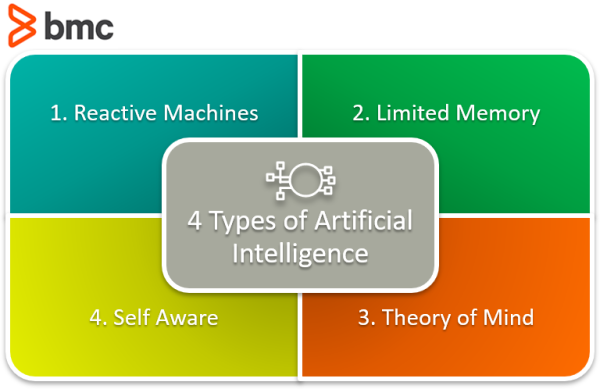We are further down the road of A.I. As we grow in understanding, so, too, do we grow to understand its differences.
In 2020, we can classify A.I. into 4 distinct types. The types are loosely similar to Maslov’s hierarchy of needs, where the simplest level only requires basic functioning and the most advanced level is the Mohammad, Buddha, Christian Saint, all-knowing, all-seeing, self-aware consciousness.
The four A.I. types are
- Reactive Machines
- Limited Memory
- Theory of Mind
- Self Aware
We are currently well past the first type and actively perfecting the second. At the moment, the third and fourth types exist in theory. They are to be the next stage of A.I.—let’s take a look.

Reactive Machines
Reactive Machines perform basic operations. This level of A.I. is the simplest. These types react to some input with some output. There is no learning that occurs. This is the first stage to any A.I. system. A machine learning that takes a human face as input and outputs a box around the face to identify it as a face is a simple, reactive machine. The model stores no inputs, it performs no learning.
Static machine learning models are reactive machines. Their architecture is the simplest and they can be found on GitHub repos across the web. These models can be downloaded, traded, passed around and loaded into a developer’s toolkit with ease.
Limited Memory
Limited memory types refer to an A.I.’s ability to store previous data and/or predictions, using that data to make better predictions. With Limited Memory, machine learning architecture becomes a little more complex. Every machine learning model requires limited memory to be created, but the model can get deployed as a reactive machine type.
There are three major kinds of machine learning models that achieve this Limited Memory type:
Reinforcement learning
These models learn to make better predictions through many cycles of trial and error. This kind of model is used to teach computers how to play games like Chess, Go, and DOTA2
Long Short Term Memory (LSTMs)
Researchers intuited that past data would help predict the next items in sequences, particularly in language, so they developed a model that used what was called the Long Short Term Memory. For predicting the next elements in a sequence, the LSTM tags more recent information as more important and items further in the past as less important.
Evolutionary Generative Adversarial Networks (E-GAN)
The E-GAN has memory such that it evolves at every evolution. The model produces a kind of growing thing. Growing things don’t take the same path every time, the paths get to be slightly modified because statistics is a math of chance, not a math of exactness. In the modifications, the model may find a better path, a path of least resistance. The next generation of the model mutates and evolves towards the path its ancestor found in error.
In a way, the E-GAN creates a simulation similar to how humans have evolved on this planet. Each child, in perfect, successful reproduction, is better equipped to live an extraordinary life than its parent.
Limited Memory Types in practice
While every machine learning model is created using limited memory, they don’t always become that way when deployed.
Limited Memory A.I. works in two ways:
- A team continuously trains a model on new data.
- The A.I. environment is built in a way where models are automatically trained and renewed upon model usage and behavior.
For a machine learning infrastructure to sustain a limited memory type, the infrastructure requires machine learning to be built-in to its structure.
More and more common in the ML lifecycle is Active Learning. The ML Active Learning Cycle has six steps:
- Training Data. An ML model must have data to train on.
- Build ML Model. The model is created.
- Model Predictions. The model makes predictions,
- Feedback. The model gets feedback on its prediction from human or environmental stimuli.
- Feedback becomes data. Feedback is submitted back to a data repository.
- Repeat Step 1. Continue to iterate on this cycle.
Theory of Mind
We have yet to reach Theory of Mind artificial intelligence types. These are only in their beginning phases and can be seen in things like self-driving cars. In this type of A.I., A.I. begins to interact with the thoughts and emotions of humans.
Presently, machine learning models do a lot for a person directed at achieving a task. Current models have a one-way relationship with A.I. Alexa and Siri bow to every command. If you angrily yell at Google Maps to take you another direction, it does not offer emotional support and say, “This is the fastest direction. Who may I call and inform you will be late?” Google Maps, instead, continues to return the same traffic reports and ETAs that it had already shown and has no concern for your distress.
A Theory of Mind A.I. will be a better companion.
Fields of study tackling this issue include Artificial Emotional Intelligence and developments in the theory of Decision-Making. Michael Jordan presented some of his Decision-Making research at the May 13th event, The Future of ML and AI with Michael Jordan and Ion Stoica, and more coverage was presented at the ICLR 2020 conference.
Self-Aware
Finally, in some distant future, perhaps A.I. achieves nirvana. It becomes self-aware. This kind of A.I. exists only in story, and, as stories often do, instills both immense amounts of hope and fear into audiences. A self-aware intelligence beyond the human has an independent intelligence, and likely, people will have to negotiate terms with the entity it created. What happens, good or bad, is anyone’s guess.
Are there other AI types?
There are other types of A.I. the more tech-oriented crowd observes. They follow a similar outline but get written about with a stronger foundation in what the A.I. is used for, what it is capable of, and how it helps advance humanity. These three types are:
- Artificial Narrow Intelligence
- Artificial General Intelligence
- Artificial Super Intelligence
Whichever way you break down A.I., know that it A.I. is a strong software tool for the future that’s here to stay. A.I. is eliminating repetitive tasks in the workforce and elevating humans to reach higher selves, embracing constant states of change and creativity.
Additional resources
For more on AI and machine learning, check out these articles from BMC Blogs:






